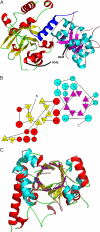Crystal structure of the Agrobacterium virulence complex VirE1-VirE2 reveals a flexible protein that can accommodate different partners
- PMID: 18678909
- PMCID: PMC2516231
- DOI: 10.1073/pnas.0801525105
Crystal structure of the Agrobacterium virulence complex VirE1-VirE2 reveals a flexible protein that can accommodate different partners
Abstract
Agrobacterium tumefaciens infects its plant hosts by a mechanism of horizontal gene transfer. This capability has led to its widespread use in artificial genetic transformation. In addition to DNA, the bacterium delivers an abundant ssDNA binding protein, VirE2, whose roles in the host include protection from cytoplasmic nucleases and adaptation for nuclear import. In Agrobacterium, VirE2 is bound to its acidic chaperone VirE1. When expressed in vitro in the absence of VirE1, VirE2 is prone to oligomerization and forms disordered filamentous aggregates. These filaments adopt an ordered solenoidal form in the presence of ssDNA, which was characterized previously by electron microscopy and three-dimensional image processing. VirE2 coexpressed in vitro with VirE1 forms a soluble heterodimer. VirE1 thus prevents VirE2 oligomerization and competes with its binding to ssDNA. We present here a crystal structure of VirE2 in complex with VirE1, showing that VirE2 is composed of two independent domains presenting a novel fold, joined by a flexible linker. Electrostatic interactions with VirE1 cement the two domains of VirE2 into a locked form. Comparison with the electron microscopy structure indicates that the VirE2 domains adopt different relative orientations. We suggest that the flexible linker between the domains enables VirE2 to accommodate its different binding partners.
Conflict of interest statement
The authors declare no conflict of interest.
Figures




Similar articles
-
Plant transformation by Agrobacterium tumefaciens: modulation of single-stranded DNA-VirE2 complex assembly by VirE1.J Biol Chem. 2007 Feb 9;282(6):3458-64. doi: 10.1074/jbc.M605270200. Epub 2006 Oct 23. J Biol Chem. 2007. PMID: 17060320
-
The Agrobacterium tumefaciens chaperone-like protein, VirE1, interacts with VirE2 at domains required for single-stranded DNA binding and cooperative interaction.J Bacteriol. 1999 Nov;181(21):6850-5. doi: 10.1128/JB.181.21.6850-6855.1999. J Bacteriol. 1999. PMID: 10542192 Free PMC article.
-
Mutagenesis of the Agrobacterium VirE2 single-stranded DNA-binding protein identifies regions required for self-association and interaction with VirE1 and a permissive site for hybrid protein construction.J Bacteriol. 1999 Jul;181(14):4342-52. doi: 10.1128/JB.181.14.4342-4352.1999. J Bacteriol. 1999. PMID: 10400593 Free PMC article.
-
Protein apparatus for horizontal transfer of agrobacterial T-DNA to eukaryotic cells.Biochemistry (Mosc). 2013 Dec;78(12):1321-32. doi: 10.1134/S000629791312002X. Biochemistry (Mosc). 2013. PMID: 24460966 Review.
-
Agrobacterium tumefaciens and A. rhizogenes use different proteins to transport bacterial DNA into the plant cell nucleus.Microb Biotechnol. 2009 Jul;2(4):416-27. doi: 10.1111/j.1751-7915.2009.00104.x. Epub 2009 Apr 6. Microb Biotechnol. 2009. PMID: 21255274 Free PMC article. Review.
Cited by
-
The roles of bacterial and host plant factors in Agrobacterium-mediated genetic transformation.Int J Dev Biol. 2013;57(6-8):467-81. doi: 10.1387/ijdb.130199bl. Int J Dev Biol. 2013. PMID: 24166430 Free PMC article. Review.
-
A tau class GST, OsGSTU5, interacts with VirE2 and modulates the Agrobacterium-mediated transformation in rice.Plant Cell Rep. 2022 Apr;41(4):873-891. doi: 10.1007/s00299-021-02824-z. Epub 2022 Jan 24. Plant Cell Rep. 2022. PMID: 35067774
-
The coupling protein Cagbeta and its interaction partner CagZ are required for type IV secretion of the Helicobacter pylori CagA protein.Infect Immun. 2010 Dec;78(12):5244-51. doi: 10.1128/IAI.00796-10. Epub 2010 Sep 27. Infect Immun. 2010. PMID: 20876293 Free PMC article.
-
Biological diversity of prokaryotic type IV secretion systems.Microbiol Mol Biol Rev. 2009 Dec;73(4):775-808. doi: 10.1128/MMBR.00023-09. Microbiol Mol Biol Rev. 2009. PMID: 19946141 Free PMC article. Review.
-
Direct visualization of Agrobacterium-delivered VirE2 in recipient cells.Plant J. 2014 Feb;77(3):487-95. doi: 10.1111/tpj.12397. Epub 2014 Jan 16. Plant J. 2014. PMID: 24299048 Free PMC article.
References
-
- Chilton MD, et al. Stable incorporation of plasmid DNA into higher plant cells: The molecular basis of crown gall tumorigenesis. Cell. 1977;11:263–271. - PubMed
-
- Zupan J, Muth TR, Draper O, Zambryski P. The transfer of DNA from agrobacterium tumefaciens into plants: A feast of fundamental insights. Plant J. 2000;23:11–28. - PubMed
-
- Tzfira T, Citovsky V. Agrobacterium-mediated genetic transformation of plants: Biology and biotechnology. Curr Opin Biotechnol. 2006;17:147–154. - PubMed
Publication types
MeSH terms
Substances
Associated data
- Actions
LinkOut - more resources
Full Text Sources
Other Literature Sources
Molecular Biology Databases

